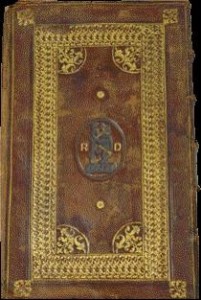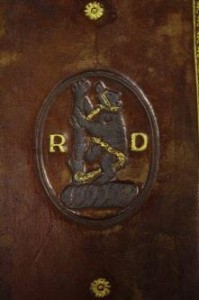The Derry and Raphoe Diocesan Library: a bibliographical archaeological site
Published in 18th–19th - Century History, Early Modern History (1500–1700), Features, General, Issue 6 (Nov/Dec 2009), Volume 17 The establishment of a Diocesan Library and the Diocesan Free School were intended to provide the diocese of Derry with a seat of learning. Established in 1617, shortly after the appointment of George Downham as bishopand following the visit to Derry of two assistants of the Irish Society, George Smithies and Matthias Springham, the latter decided to provide a school at his own expense. The Free School was built between present-day Palace Street and Society Street (formerly Free School Lane) and continued to exist inside the city walls until it moved to Lawrence Hill on the city’s northern outskirts in 1814, where it subsequently became Foyle College. Later still the Foyle College building became part of the Magee campus of the University of Ulster. Colby’s Ordnance Survey of the County of Londonderry (1837) describes the Free School as ‘a capacious house . . . the lower rooms to serve for a school, with accommodation for the master, and the upper rooms for a library’. The library moved with the school to Foyle College and then to the Diocesan Office in London Street, where, gradually, it began to fade from all but local memory.
The establishment of a Diocesan Library and the Diocesan Free School were intended to provide the diocese of Derry with a seat of learning. Established in 1617, shortly after the appointment of George Downham as bishopand following the visit to Derry of two assistants of the Irish Society, George Smithies and Matthias Springham, the latter decided to provide a school at his own expense. The Free School was built between present-day Palace Street and Society Street (formerly Free School Lane) and continued to exist inside the city walls until it moved to Lawrence Hill on the city’s northern outskirts in 1814, where it subsequently became Foyle College. Later still the Foyle College building became part of the Magee campus of the University of Ulster. Colby’s Ordnance Survey of the County of Londonderry (1837) describes the Free School as ‘a capacious house . . . the lower rooms to serve for a school, with accommodation for the master, and the upper rooms for a library’. The library moved with the school to Foyle College and then to the Diocesan Office in London Street, where, gradually, it began to fade from all but local memory.
Decline into obscurity presented opportunity
The library did not restrict itself to religious texts. All branches of knowledge are covered: canon and secular law, the classics, the sciences, history, geography, and obviously theology—but even the latter is not limited to Anglican works; there are early studies of Islam, as well as volumes of Roman Catholic, Presbyterian and Quaker texts. It is by no means just a local collection: books came from all the major printing centres of Britain, Ireland and Europe. By the early nineteenth century, however, owing to a lack of funds, the fortunes of the library began to decline, leading to the physical deterioration of the books and the obscurity that persisted until recently.
But what was a problem then is now regarded as a fortunate accident, since the library escaped the well-intentioned restoration and re-binding that has afflicted so many other collections. The apparent slide into decline and obscurity in fact preserved what is now more than a library: it is a bibliographical archaeological site that is now being excavated and recorded in a unique partnership between the diocese of Derry and Raphoe and the University of Ulster, supported by the Heritage Lottery Fund, the Heritage Council, the Honourable the Irish Society and others. Conservation follows the principle of minimum intervention to stabilise the individual volumes as artefacts. Their study will enable us to learn much about the book trade itself (by examining the construction and binding of the volumes from the hand-press period, before c. 1830) and about the intellectual trade routes by which these books found their way to Derry (by examining provenance evidence such as signatures, marginalia and even personal bindings). Both these classes of evidence would have been lost, or at least compromised, had the necessary funds for re-binding been available in 1837.
In 1834 the diocese of Raphoe was annexed to Derry following the death of its last bishop, William Bissett, and the two libraries were merged in the late nineteenth century. Printed catalogues appeared in 1848 and 1880 (Derry) and 1868 (Raphoe), but these proved less than adequate. A shelf-list of the joined collections, completed in the 1930s, improved on the printed catalogues, but the collection remains essentially uncatalogued, a situation now being remedied.
Answers yielded and questions posed

Book belonging to Robert Dudley, earl of Leicester.
Even at this early stage of cataloguing it is clear that the collection has enormous research potential. The recording of previous ownership has already yielded some answers but also posed some questions. The Hopkins, Downham and Harrison signatures are easily explained by the bishops’ direct and Harrison’s indirect connections with the diocese. The associations with local families and benefactors similarly account for names such as Torrens and Knox, but there are some puzzles. Is the inscription of the initials ‘A.H.’ on a book with a Downham signature a mark of Ann Harrison’s ownership? What can we make of the apparent signature of the seventeenth-century poet Francis Quarles on a book printed two years after his death? Other finds include the signature of the dramatist Ben Jonson. There is a fine binding that certainly belonged to Robert Dudley, earl of Leicester, as well as a more battered volume bound for Sir Walter Raleigh. The bindings in the collection offer a rich seam of book history to be mined. Most of them are contemporary with the books they enclose and in some cases have suffered centuries of neglect, but this may, ironically, facilitate study of book construction. Damage to leather and boards has revealed manuscript fragments and other examples of printer’s waste used as strengthening material, which, in an undamaged volume, would remain invisible. Other covers, some now 500 years old, were intended to be temporary, i.e. to protect the text-block of the book until such time as the new owner got round to having it bound properly, which in many cases never happened. Many of these are parchment or vellum; one is a sixteenth-century bookseller’s handwritten stock list, giving the titles and prices of his books, wrapped around a French-printed account of the Tridentine Council!
A further potential topic for research would be to trace Bishop King’s disposal of the books he collected to the libraries at Derry and at Cashel, by examining the numbering done inside the front covers or sometimes on the title-pages, presumably on King’s instructions. Many of the inscriptions were done very quickly, evidenced by the fact that the books were closed before the ink had dried, leaving an offset impression on the opposite page. This is probably what gave rise to the story that Bishop Hopkins had packed the books in boxes on the quayside to ship to England when he was fleeing Derry after the closing of the city’s gates in 1688. While that particular legend has been debunked, it is clear that this library, a remarkable survival from the great age of Irish episcopal library formation, still has plenty of stories left to tell. HI
Joe McLaughlin is Archivist and Rare Books Curator at the University of Ulster.
Further information:
www.derryraphoelibrary.org
















